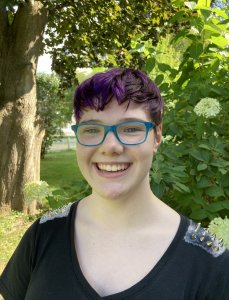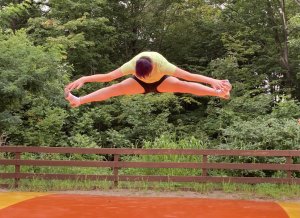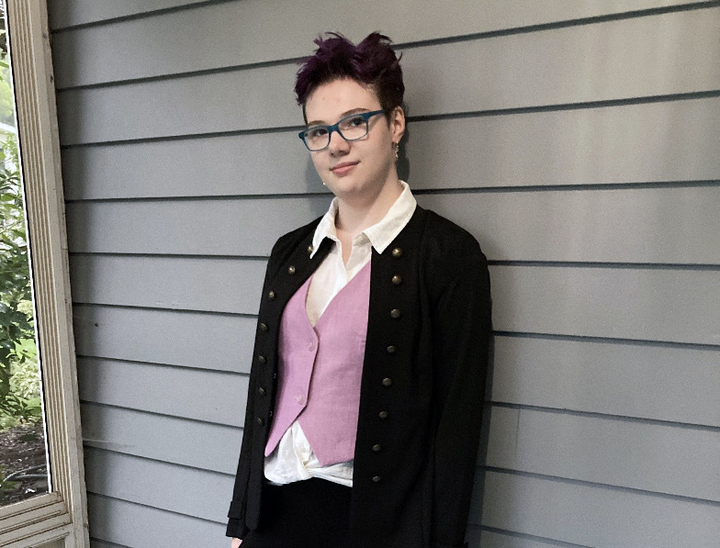ALBANY — When 15-year-old Oneida County resident Matilda Terrell caught COVID-19 for the first time in July 2022, Matilda’s symptoms were mild and they recovered quickly.
But, when they contracted the virus for the second time two months later, their life changed dramatically.
Matilda, who uses they/them pronouns, went from being a happy, well-balanced kid to having severe depression and suicidal ideation almost overnight, according to their mother, Katherine Terrell. When they contracted the virus for a third time in January 2023, they started experiencing crushing fatigue, body aches, a constant headache, brain fog that left them struggling to even read a page, post-exertional malaise, a spiking heart rate, and worsened irritable bowel syndrome symptoms, among others.

Matilda’s mother Katherine described Matilda as a “happy kid” before they developed long COVID. (Courtesy Katherine Terrell)
“It is heartbreaking to see their life reduced to this,” Terrell said. “This is a kid who had just boundless energy their entire life — they would do a full day of school, get all A’s, and then have three hours of dance class before coming home, doing their homework, and going to bed. Now, it’s an accomplishment if they can get out and walk a few blocks.”
Matilda is one of the estimated 18 million Americans who have suffered from residual side effects of COVID-19, known as long COVID-19. The Centers for Disease Control and Prevention estimates that nearly one in five adults who had the virus now have long COVID-19.
According to the National Institutes of Health, there are more than 200 documented long COVID-19 symptoms, which include memory impediments, excessive fatigue, shortness of breath and cognitive impairment.
However, there are no FDA-approved treatments approved by the U.S. Food and Drug Administration to treat the condition. Matilda says their physician told them to “just wait and hope that the research gets done.”
Call for government action
Earlier this year, patients and experts urged the government to declare long COVID-19 a national emergency during a Senate Committee on Health, Education, Labor and Pensions hearing. If declared, the government will be able to fund long COVID-19 research and expedite clinical trials.
In the months following the hearing, the CDC cut its five-day isolation recommendation to one day, a move some public health experts say will lead to more people contracting the virus and developing long COVID-19.
A study conducted by a team of epidemiologists at Washington University in St. Louis found that the risk of getting long COVID-19 increases with each reinfection. Ziyad Al-Aly, one of the authors of the study, worries that public health officials are failing to inform the public about the risks.
“I think the CDC just wanted to change the guidelines because they got sick and tired of the pandemic,” Al-Aly said. “But the facts are that people are still getting COVID infections. Everyone is at risk of long COVID, and I don’t think many people realize that.
President Joe Biden addressed the coronavirus pandemic in his recent State of the Union address, declaring that “the pandemic no longer controls our lives.”
However, for many long COVID-19 patients, like 63-year-old Georgia resident Marjorie Roberts, the pandemic isn’t over. When Roberts contracted the virus in March 2020, she said she suffered from poor balance, nausea, vomiting, and diarrhea, among other issues.
She still has not fully recovered.
Roberts said she believes the government has overlooked long COVID-19. She traveled to Washington, D.C., to deliver a speech last Friday in hopes of bringing the issue to the forefront of public attention.
“I want somebody to hear us, somebody to feel our pain,” Roberts said. “Biden didn’t bring Washington to me, so I’m taking myself to Washington to him. We are a big part of the… union.”

Matilda does a split in the air at the Utica Zoo in Utica, NY. Matilda’s mother Katherine says that Matilda had “boundless energy” before getting long COVID. (Courtesy Katherine Terrell)
Mental health toll
Pam Bishop, a 48-year-old Knoxville, Tenn., resident grappling with long COVID-19, said the lack of public awareness about the condition has fueled loneliness in the community.
Before contracting long COVID-19, Bishop was the director of The National Institute for Stem Evaluation and Research at the University of Tennessee. However, Bishop said she only leaves her home now when it is absolutely necessary, which has made it difficult for her to keep in touch with friends.
“If we’re going to do something I have to know about it beforehand because I have to rest and make sure that my schedule is clear afterwards,” Bishop said. “It is very isolating to be sick like this because you’re exhausted all the time and it’s hard to make plans with people. So, I end up not making plans most of the time.”
Matilda said they went from being a happy kid to “being overwhelmed by suicidal thoughts and wanting to kill myself on a daily basis” after developing long COVID-19. Katherine says that it’s been hard for Matilda to keep up with their friendships because they are constantly missing school and out-of-school activities.
“These are the days where you’re supposed to be spending all your time with friends and going out to parties,” Matilda said. “And because of long COVID, I can’t do any of that. I feel isolated and alone and that’s really hard.”
Financial hardship
The Brookings Institution estimates that as many as 4 million Americans are out of work because of the lingering effects of COVID-19.
Among those sidelined by long COVID-19 is Meighan Stone, who said she can now barely leave her house because of debilitating symptoms from the virus.
Stone had a career in advocacy, working for organizations like the Malala Fund and the Council on Foreign Relations before long COVID-19 symptoms forced her to leave her field. Stone has recently started part-time remote consulting. However, she said it is still not financially sustainable.
She had to transition from Medicaid to private insurance because Medicaid wouldn’t cover the cost of low-dose Naltrexone, a drug that is not yet FDA-approved but has given Stone some relief, she said. The single mother said she wouldn’t be able to afford insurance if it weren’t for the generosity of friends.
Stone’s doctors have encouraged her to apply for Social Security Disability Insurance, but she says she knows she wouldn’t be able to complete the application on her own and doesn’t have the financial resources to hire an attorney.
“I need to spend those resources on taking care of me and my son today,” Stone said. “The disability system is so broken in the United States.”
Andrew Wylam is the co-founder and president of Pandemic Patients, a nonprofit organization that connects those affected by COVID-19 with a network of attorneys who can provide pro-bono legal assistance. Wylam said that applying for disability insurance is an “arduous” process that is particularly challenging for long COVID-19 patients who have cognitive impairments.
“I look at some of the paperwork that you have to go through and all the medical documentation that you have to provide, and I think that can be challenging for someone with average cognitive capacity,” Wylam said. “When you add on the cognitive disability to a person’s symptoms, the process of going through the application and appeals is just overwhelming.”
Wylam said that he’s worked with patients who have applied for Social Security disability insurance and had to wait more than two years for a response. During this time, they are without a steady flow of income, he said.
During the Senate HELP hearing, Rachel Beale, a long COVID-19 patient from Southampton County in Virginia, testified that she was denied Social Security Disability disability insurance twice without any explanation, despite the condition being recognized as a disability under the Americans with Disabilities Act. As a result, she has to pay an estimated $4,000 annually out of pocket and cut back on services that help her manage her chronic pain.
Many of Wylam’s clients have been diagnosed with serious medical conditions and post-viral syndromes that have been brought on by long COVID-19. Wylam said that it can be difficult for patients living with these invisible illnesses to prove they are suffering from symptoms like brain fog, excessive fatigue and difficulty concentrating, which in turn makes it more challenging for them to obtain disability insurance.
When Olenka Sayko went to the emergency room with symptoms of a nervous system disorder a week after testing positive with COVID-19, Sayko said she was told her symptoms were all in her head. This experience of being “gaslit” and dismissed by medical professionals is all too common among long COVID-19 patients, according to Sayko.
In addition to funding for clinical research, the group LC/DC is calling on the government to promote educational campaigns and increase social services for long COVID-19 patients.
“We have a long way to go, and we need to do it quickly because people are suffering,” said Dara York, a founder of LC/DC. “How much longer will we have to stand up and fight?”



